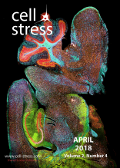Table of contents
Volume 2, Issue 4, pp. 72 - 95, April 2018
Cover: This month in
Cell Stress: Snap29 in synaptic transmission and cellular health. Image depicts the brain of a mouse with the neurodegenerative disease Niemann-Pick type C1. Credit: NICHD/I. Williams; licensed under the
CC BY 2.0 license. Image modified by
Cell Stress. The cover is published under the
CC BY 4.0 license.
Enlarge issue cover
How to use a multipurpose SNARE: The emerging role of Snap29 in cellular health
Valeria Mastrodonato, Elena Morelli and Thomas Vaccari
Reviews |
page 72-81 | 10.15698/cst2018.04.130 | Full text | PDF |
Abstract
Despite extensive study, regulation of membrane trafficking is incompletely understood. In particular, the specific role of SNARE (Soluble NSF Attachment REceptor) proteins for distinct trafficking steps and their mechanism of action, beyond the core function in membrane fusion, are still elusive. Snap29 is a SNARE protein related to Snap25 that gathered a lot of attention in recent years. Here, we review the study of Snap29 and its emerging involvement in autophagy, a self eating process that is key to cell adaptation to changing environments, and in other trafficking pathways. We also discuss Snap29 role in synaptic transmission and in cell division, which might extend the repertoire of SNARE-mediated functions. Finally, we present evidence connecting Snap29 to human disease, highlighting the importance of Snap29 function in tissue development and homeostasis.
Assay for high-throughput screening of inhibitors of the ASC-PYD inflammasome core filament
Lorenzo Sborgi, Johanna Ude, Mathias S. Dick, Jonathan Vesin, Marc Chambon, Gerardo Turcatti, Petr Broz, Sebastian Hiller
Research Articles |
page 82-90 | 10.15698/cst2018.04.131 | Full text | PDF |
Abstract
The protein ASC is a central component of most inflammasome complexes, forming functional oligomeric filaments that activate large amounts of pro-caspase-1 for further IL-1β processing and the induction of Gasdermin D-dependent cell death. The central role of inflammasomes in the innate immune response pose them as new molecular targets for therapy of diverse acute, chronic and inherited autoinflammatory pathologies. In recent years, an increasing number of molecules were proposed to modulate inflammasome signalling by interacting with different components of inflammasome complexes. However, the difficult in vitro reconstitution of the inflammasome has limited the development of specific on-target biochemical assays for compound activity confirmation and for drug discovery in high throughput screening setups. Here we describe a homogeneous, pH-based ASC oligomerization assay that employs fluorescence anisotropy (FA) to monitor the in vitro filament formation of the PYD domain of human ASC. The absence of additional solubility tags as well as of proteolytic enzymes to initiate the filament reaction makes this assay suitable for testing the direct effect of small molecules on filament formation in high throughput format. The ability of the assay to detect modulators of filament formation was confirmed by using a non-filament forming PYD mutant. The high and reproducible Z’-factor of 0.7 allowed to screen 10,100 compounds by high-throughput screening (HTS) aiming to identify inhibitors of ASC filament. While none of these molecules was able to inhibit ASC filament formation in vitro, the assay is directly amenable to screen other compound classes or validate candidate molecules from other screens.
New insights into the key role of HIF-1α in IL-10-producing B cells
Xianyi Meng, Aline Bozec
Microreviews |
page 94-95 | 10.15698/cst2018.04.133 | Full text | PDF |
Abstract
Hypoxia-inducible factors (HIFs) are essential transcription factors for the cellular response to hypoxia. Expression and stabilization of HIFs can be triggered by hypoxia or by other factors under pathological stress such as inflammation and infection. Indeed, regulatory function of HIFs has been implicated in a variety of different immune cells like macrophages and T cells. In our recent study, we delineated HIF-1α and HIF-2α roles in B cells (Nat Commun, 9:251). We demonstrated that lack of HIF-1α in B cells leads to impaired IL-10-producing CD1dhiCD5+ B cells expansion by modulating their glycolytic metabolism. We identified HIF-1α as a critical transcriptional factor involved in IL-10 production by B cells, thereby influencing the course of autoimmune diseases.
Oxidation of p62 as an evolutionary adaptation to promote autophagy in stress conditions
Elsje G. Otten, Rhoda Stefanatos, Bernadette Carroll, Viktor I. Korolchuk
Microreviews |
page 91-93 | 10.15698/cst2018.04.132 | Full text | PDF |
Abstract
Ageing and age-related diseases are characterised by increased oxidative and proteotoxic stress, which results in negative effects on cell function and survival. The cell possesses several mechanisms to deal with damaged proteins, including degradation via macroautophagy (hereafter called autophagy). This essential cellular pathway is conserved from yeast to humans and it is well established that its impairment reduces lifespan in multiple model organisms, including worms, flies and mice. In our study, recently published in Nature Communications, we asked if longer lifespan characteristic of higher organisms is the result of evolutionary adaptations to the autophagy machinery. We found that the autophagy receptor p62 can be oxidised leading to its oligomerisation which ultimately promotes autophagy. However this mechanism, present in vertebrates, has been acquired late in evolution. We propose that the ability of p62 to sense reactive oxygen species (ROS) via oxidation, and potentially other similar modifications, may have evolved in higher organisms and contributed to their increased lifespan. Indeed, impairment of this process could result in age-related neurodegeneration in humans.



